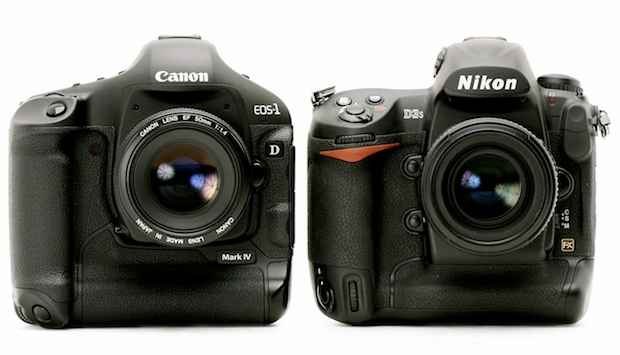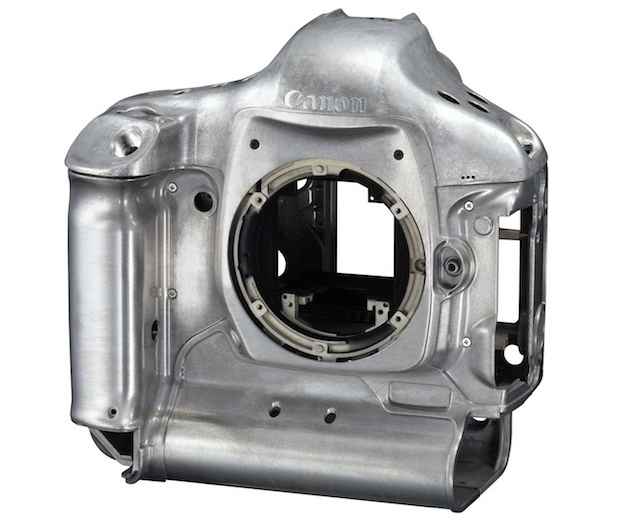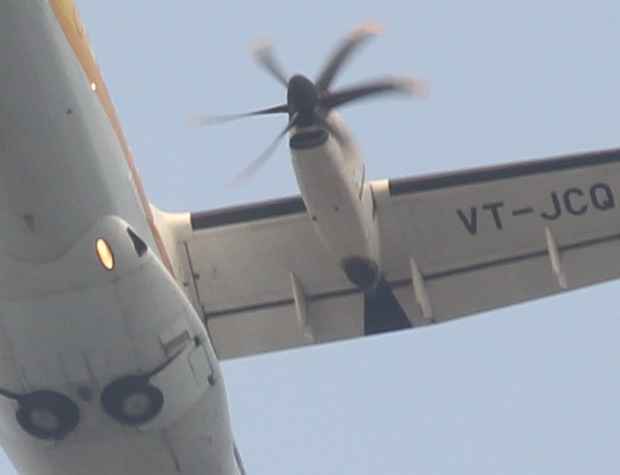Canon EOS 1D Mark 4 – A quality crop, but full frames are cheaper Review
The 1D Mark 4 is a joy to shoot with and an extremely well built and great performing dSLR – a true pro photography tool. We’d like button placement to be a little more optimised (like the 7D), but that aside, there’s little to complain about. The real competition comes from full frames like the Canon 5Dmk2 and Nikon D3s. For Rs. 2,59,995, the Mark 4 is very expensive and strictly for those pros who value speed, work in low-light, and want the best non-full frame sensor around.
The answer to that is no less complex, and if we were to guess, (and remember that this is our theory and not necessarily fact), would be binary. For one, Canon doesn’t have really fast full frame cameras, with the 5Dmk2 managing 3.9 fps, and the 1Ds Mark 3 doing 5 fps. But reduce the sensor size, lower the megapixel count, and you can push through more images, and Canon needed something for the sports photographer for whom 8-9 fps is bread and butter. After all, you don’t want to miss a world record being broken, shooting at 4 fps and discovering that none of the shots capture the “magical” moment, do you? So the Mark 4 was born of necessity. There is another reason. Such a sensor is cheaper to manufacture than a full frame, meaning Canon probably makes a larger profit on each Mark 4 sold than Nikon does on their D3s, conversely, this leaves more headroom for research spending on other components. Thirdly, full frames are known to be soft at corners, vignetting or light fall off, is more of a problem on these larger sensors. The 1.6x crop factor is good, but it was never going to be great at low light photography, therefore the answer lay in the middle ground i.e. the APS-H sensor.
Look and feel
The 1D Mark 4 is a solidly built camera with an integrated vertical grip. Compared to the D3s, the rubber grip feels a lot less luxurious and a little “skimpy”. The D3s is also heavier by at least 150 grams, but this is attributable to the larger sensor and surrounding elements. One plus is that while the Mark 4s grip seems imbued with thinner rubber, and is harder, the rubber seems to react less to sweat. We found the D3s grip a little more susceptible to wearing with a lot of sweat on it, the rubber seemed to loose its outer finish and gradually erode, (for lack of a better word), while the Mark 4 seemed to wear better. Both cameras feel comfortable. The Mark 4 is the same width as the Canon 7D , and a little narrower than the 5D Mark 2. Sitting next to the Nikon D3s, its higher than it in height but a little narrower in depth, with a noticeably smaller pentaprism bulge, which is obvious given the huge viewfinder that full frame cameras have. Interestingly, the viewfinder bulge is no larger than the 7D.
The battery slides into the vertical grip and the locking mechanism is fixed to the battery and not detachable like the D3s. The battery is rated at 2,300 mAh at 26Wh. Just above the battery bay are three rubberised flaps concealing various ports like the mini HDMI, mini USB AV out, microphone and wireless flash and GPS port. These flaps are soft enough to weather seal properly and the Mark 4 boasts of environment sealing with dust and moisture gaskets around controls, bays and body seams. The chassis is built of magnesium alloy and the Mark 4 feels like a brick. It doesn’t take a genius to spot the rubber surrounding buttons, and there are sure to be gaskets inside as well, Canon boasts the Mark 4 has seen numerous trips to harsh environments like deserts and the Antarctic without any problem, and this seems a a viable claim. Incidentally, like the 7D, the Mark 4 has toughened glass on its LCD, which is pretty resistant to scratches. Therefore the LCD doesn’t need (or ship with) a hard plastic cover like Nikon ships with their cameras. Likewise, the buttons and especially the dials seems very well built, just like the ones on the EOS 7D. We love Canon’s top dial and its clicky feedback. It is much better than the front-facing dial that Nikon uses, which in our experience gradually recedes into the body over a couple of years with the pressure required to operate it; we’ve recorded no such issue with Canon dSLRs.
The memory card bay is revealed via a twist control that raises a flap. Inside are two memory slots. The Mark 4 has one CF card and one SD card. As expected from a camera of this calibre, the Mark 4 misses a flash unit. The control and dial system is classic Canon, and people migrating from a 50D or 7D will be right at home, with one very significant change which we’ll talk about a bit later. The vertical grip has quite a few controls too, and we love the recessed power on/off switch for the vertical grip controls, which means you cannot accidentally use any of these controls – a good feature, and one the D3s misses. Like most vertical grip bodies, the Mark 4 has two status LCDs, one on the top and one beneath the main LCD. The backlighting is blue, and while this looks less cool compared to the D3s’ green colour, it is a notch up from the likes of the Nikon D300s and the Nikon D7000, as the LEDs lighting the displays are not visible and the backlight is even. The display LCD on top is smaller than the one on the 5Dmk2, and the battery status indicator is not as detailed as the one on the 7D. A quick word on the viewfinder. It is quite large and bright, and positively huge for people who have worked with the likes of Canon’s EOS 450D and 500D that have paltry viewfinders, dim little things that will have you squinting even in mediocre light. However, it is not up to the bright, large viewfinders found on full frame cameras like the 5Dmk2 and D3s, and shockingly, feels smaller than the viewfinder on the EOS 7D which seems marginally brighter. Incidentally, there is a shutter that blocks the viewfinder (like the D3s has), useful when shooting long exposures and you don’t want light leaking on to the sensor via the viewfinder.
Unlike the 7D and for the most the 5Dmk2 that nailed ergonomics spot on, the Mark 4 has a few issues with key button positions that prevent it from being termed as really ergonomic. First of all lets compare the vertical grip component. The controls clustered around the vertical grip are not very useful in manual mode, and neither is either LCD, because unlike the D3s, the Mark 4 doesn’t display the same controls on the bottom LCD, and one needs to keep tilting the camera to peek at the top status LCD to know what settings are being changed, and as a . You’ll also have to use the buttons around the top status LCD – not very convenient when using the Mark 4 vertically oriented. We mentioned a significant change in the beginning of the previous para – all the buttons that we’re using to seeing on the left side of the LCD are gone! These buttons are now placed below the rear status LCD. The uber useful one touch RAW button found on the 7D is absent. Gone too is the dial on the top left, replaced by three buttons for mode, AF drive and a single button that serves as a control for metering or exposure compensation depending on which dial you use.
[RELATED_ARTICLE]While the absence of the mode dial is understandable given the pro nature of the Mark 4, there’s no escaping the fact that the buttons are more cleanly and intuitively laid out on the 7D, which is quite a shame given the fact that it is one third the price of the Mark 4. The D3s has a much better layout, and while there are some duplicate controls, you can use it horizontally and vertically without feeling a pinch in ergonomics either way. To put this into perspective, the Mark 4 will be perfectly usable once you get used to it, and is not “bad” by any stretch of the imagination, however, it could have been, and should have been, a little more intuitive. Compared to the 7D that released about the same time, it seems Canon gave up a bit on ergonomics, but then the 7D is about as close to perfect as we’ve seen. The Mark 4 has incredibly detailed menus, and while this will be overwhelming to some, pros will feel right at home. Although we occasionally found ourselves lost in the custom menu, it is easy to appreciate the fact that nearly everything is customisable to your needs.
Features
Let’s take a look at some of the salient features on the Canon EOS 1D Mark 4:
- 16 megapixel APS-H sensor
- 45 point autofocus system with 39 cross-type points
- Native support for ISO 12,800
- Support for EF lenses only
- Dual memory slots – one CF and one SD
- 10 fps burst mode
- 2,300 mAh battery
- 1080p video recording
One of the theoretical pluses of having an APS-H sensor versus a smaller APS-C sensor is the larger photosites per pixel given the same resolution. Compared to the 7D, the Mark 4 has a slightly lower megapixel count as well, and this coupled with a larger sensor means the Mark 4 should really retain more detail and show less noise at higher ISOs. However, the pixel density of the Mark 4 is greater than that of the 5Dmk2, meaning the latter will have even less noise at the same ISO. But the Mark 4 wasn’t intended solely for low light work, rather it seems to be more for sports and studio work given its rather fast speed of 10 fps.
Similar to Canons full frame offerings, The Mark 4 has only a red dot above the lens mount, this means it will only work with EF lenses, and not EF-S lenses. This will be a minus for some, as the 7D supports both types of lenses, but Canon figures if you’re buying a Mark 4, you’re a pro, and you’ll probably want the quality offered by L-series glass.
Read about its performance and our closing thoughts, on the next page…
Performance
Canon rather generously sent us 2 lenses, both L-series to be exact, no doubt they wanted the Mark 4 to perform at its best. We received the 50mm f1.2L USM and the 28-300 f3.5-5.6L IS USM. On an APS-H sensor the 50mm has an equivalent focal of 65mm, while the 28-300 will have an equivalent of 36.4-390mm, neither lens is very wide angle, but at a long end of 390mm we got a chance to use a quality telephoto. As usual, we’ll take a look at autofocus performance and image quality separately.
Autofocus
With a 45 point, with 39 cross type points, the Mark 4 has a very strong on paper spec in terms of autofocus, this is a major upgrade over the 5Dmk2’s 9 point autofocus system with only the centre point being cross type. For a bit of clarity on cross type focus points, read this portion of our EOS 7D review. The AF points are not very spread out, but to Canon’s credit, they cover a fairly large region, and unlike the 5Dmk2, are not all clustered around the centre. Also, the points are pretty brightly lit and not “etched” on the viewfinder like with older Canon cameras, including the 5Dmk2. To be honest, while the 19 points on the 7D might seem sparse, the 7D also has good viewfinder coverage in terms of focussing, but looking through both viewfinders, we get the feeling that on the 7D the points are slightly more clustered around the centre, which is not such a good thing, especially if you’re looking to focus on something that isn’t close to the centre of the viewfinder, a scenario when there’s a larger subject that you want in frame but pleasantly and unobtrusively blurred.
The Mark 4s focusses fast in good light, and it focusses accurately. In extremely dim lighting, we found the Mark 4 hunting for focus, and it failed to register focus even when there was a lighter coloured object in the scene (giving it the contrast that it needed to achieve focus lock). To be fair, the Nikon D3s faired only slightly better. However, in moderately dim conditions, the Mark 4 achieves focus, but after a bit of hunting. After using both the lens, we’d also say focus depends on the lens used, and with a highly sensitive lens with an aperture of f1.2, the Mark 4 focussed about as quickly as we’ve seen. However, we’d rate the autofocus system as a notch behind the 7Ds system, especially in poor light. It is about at par with Nikon’s 51-point with 3D tracking, but we didn’t have any Nikon dSLR with us at the time to do an objective “timed” comparison, and this comment is based on this reviewers memory, which itself is subjective!
With over 350 shots on the Mark 4, we came across some 8 shots that were slightly out of focus, and given the fact that the Mark 4 was used to shoot a couple of small sporting events, and airborne planes on more than one occasion, we have no qualms about its autofocus system. It may lack the raw speed of the 7D, and the versatility of quickly selecting clusters of AF points, but the difference is not noticeable except in dim light, and with 45 focus points with good viewfinder coverage, pros who need to autofocus will not complain.
Let’s talk a bit about video shall we? How does full HD 1080p sound? Unlike the 7D that had a dedicated video recording button, the Mark 4 feels more like a body on which video was added as an afterthought, but in terms of features, the video package isn’t any less potent, with the Mark 4 managing 1080p @30 fps.
Image quality at base ISOs (in good light)
In good light, the Mark 4 produces fine, fine images. There’s a lot of detail in JPEGs, and even more detail in RAW files, typical for a pro-body. The Mark 4 produced images with near perfect exposure, and great detail – spot on focussing, and good per pixel sharpness. One of the things we find pretty good compared to full frame sensors, is more sharpness in the corners, with less vignetting. Shooting at ISO 100 – 400 gets you clean, noise free images with a lot of detail, and more importantly, JPEGs have a fair bit of highlighting, with less highlight clipping compared to the 7D. Dynamic range is a strong point of this sensor, and while the output is typical Canon in terms of neutrality, colours appear lifelike, although you can change this if you desire. Shooting in really bright conditions does tend to produce a slightly overblown image, and you’ll need to dial in some negative exposure compensation.
Pros will be intertested to note that even JPEG files are incredibly detailed, and while RAW files have more headroom, this difference is not as wide as it is with some other cameras, where you had to shoot in RAW all the time. The Mark 4 happily serves up professional-grade JPEG files if you trust compressed image formats, although pros will almost certainly use RAW to enable after post processing.
High ISO image quality
The Mark 4 produces very usable images at ISO 3200, and retains this usability till ISO 6400. This is high praise given the sensor is much smaller than full frame. In fact at ISO 12,800, we found images pretty good, sure there is some noise evident, but it is more like analog grain than digital noise. We find ISO 25,600 of limited use, and certainly higher ISOs are pretty much there for emergencies. The Mark 4 is definitely superior to the 7D in terms of low light performance, and the sensor has at least a 2 stop advantage over the denser 7D sensor. ISO 6400 on the Mark 4 looks pretty similar to ISO 1600 on the 7D – this is a huge jump in ISO usability, given that the 7D was usable till ISO 3200.
Compared to the Nikon D3s, the Mark 4 loses some of its appeal, the larger sensor coupled with the lower pixel density gives the D3s a huge advantage that translates to more detail and less noise at ISO 12,800, although to be perfectly honest, they’re fairly comparable at ISO 6400 and below and even at 12,800, the difference is not huge – say 25 per cent, which for the sensor size and resolution is pretty fair. However, to be brutally fair, if you’re shooting in extremely low light, the Nikon D3s takes the lead. What would be interesting is comparing the 5Dmk2 to the Mark 4, but unfortunately we didn’t have one on hand at the time.
Our take
[RELATED_ARTICLE]At an MRP of 2,59,995 for the body, the Mark 4 is strictly a high-end professional body, aimed at those looking at a compromise between smaller crop sensors and full frame ones. The pluses over a full frame are great corner sharpness with less vignetting, and the possibility for more capturing frames per second. The minuses are very few, namely because the Mark 4 turns out to be a great performer in low light. The D3s is better at ISO 12,800 and above, so if you need extremely low light the D3s is better. However, if you’re going to use no more than ISO 3200, the Mark 4 will offer a higher resolution and thus more sharpness in images and more headroom for cropping than the D3s. We do not question the Mark 4’s capabilities, rather we question its price point, and just that fact that it is not a 36 x 24mm sensor will have a lot of pros ducking, irrespective of the fact that Canon has produced a very good camera. Additionally, the slightly unintuitive layout of buttons and controls, especially when compared to the EOS 7D, and also the focussing system, which while more complex, feels a hairsbreadth slower.
All in all, the Mark 4 is impressive – fast, great quality, great low light performance, ruggedly built, but for the price, it seems like it would get very few takers. There are a handful of situations in which it is better than the D3s, which is the only model competing with it in terms of price, but there are bodies like the 5Dmk2 that will get you a higher resolution if that is what you are after, but at a speed penalty. The Nikon D700 is another full frame offering at half the price. However, the Mark 4 remains a great choice for those professionals looking to get the best of both crop and full frame worlds – resolution/corner sharpness and good low-light performance in one package, all others can easily get something else and save a fair bit of dough.
Specifications: Sensor: CMOS, 16.1-megapixel, 27.8 x 18.6mm; AF: 45 point, 39 cross points; Speed: 10fps; LCD: 3.0-inch, 9,20,000 dots; battery: 2,300 mAh; weight: 1,180 grams
| Brand | Canon |
| Model | EOS 1D Mark IV |
| Price (Rupees) | |
| Specifications | |
| Sensor resolution (MegaPixel) | 4896×3264 |
| Sensor size (mm) | 27.9 x 18.6 mm |
| Sensor type | CMOS |
| Viewfinder type | Pentaprism |
| ISO (low) | 100 |
| ISO (high) | 12800 |
| Shutter speed (fastest) | 1/8000 sec |
| Shutter speed (slowest) | 30 sec |
| Auto Focus system | 45 points |
| Manual Focus (Y/N) | Y |
| Macro focus range | – |
| White balance override | Y |
| Aperture range | – |
| Built-in Flash (Y/N) | N |
| Flash range (in meters) | NA |
| External flash | Y |
| Exposure compensation range | ±3 EV (0.3 EV stops) |
| Metering | Center, Linked to AF point, Multi-spot (up to 8 readings) |
| Aperture priority (Y/N) | Y |
| Shutter priority (Y/N) | Y |
| Continuous Drive (frames per second) | 10 fps |
| Attached / kit lens zoom | – |
| LCD size | 3-inch |
| LCD Resolution (dots) | 9,20,000 |
| Image formats supported | RAW (NEF), JPEG |
| Microphone type | Mono |
| HDMI out | Y |
| Max Video capture resolution | 1920 x 1080 @ 29.97 fps |
| Battery Type (AA, Li-ion) | Li-Ion |
| Battery Capacity (mAH) | 2,300 mAh |
| Memory cards used | CF SD |
| Body dimensions (in mm) | 156 x 156.6 x 80 mm |
| Weight (in grams) | 1180 grams (without battery) |
| Build Quality (So 10) | |
| Body | 9 |
| Lens (or kit lens) | 8.5 |
| Buttons and dials | 9 |
| Bays / moving parts | 8.75 |
| LCD screen / status displays | 9 |
| Ergonomics and usability (So 10) | |
| Grip comfort, handling and feel | 7.5 |
| Layout of buttons and dials | 7.25 |
| Intutiveness of buttons and menu system | 7.75 |
| Menu layout, options and ease of use | 8 |
| Performance | |
| Focussing accuracy (wide angle) | 8.5 |
| Focussing accuracy (long end) | 8.5 |
| Quality (dynamic range, highlighting) | 8.75 |
| Quality (sharpness, micro-detail) | 8.75 |
| Image Stabilisation | – |
| High ISO tests (So 10) | |
| ISO 800 | 8.5 |
| ISO 1600 | 8.25 |
| ISO 3200 | 8.25 |
| ISO 6400 | 7.75 |
| Flash test (portrait) | – |
| Flash test (fill-scene) | – |
| Video Quality (720p) | 8 |
| Video Quality (1080p) | 8.25 |
Company: Canon India Private Limited
Phone: 1800-345-33-66
E-mail: info@canon.co.in
Website: www.canon.co.in
Price: Rs. 2,59,900 (body only); Lens: Rs. 1,76,995, Canon EF 28-300L IS USM f3.5-5.6; Canon EF 50mm f1.2L USM: Rs. 79,095







